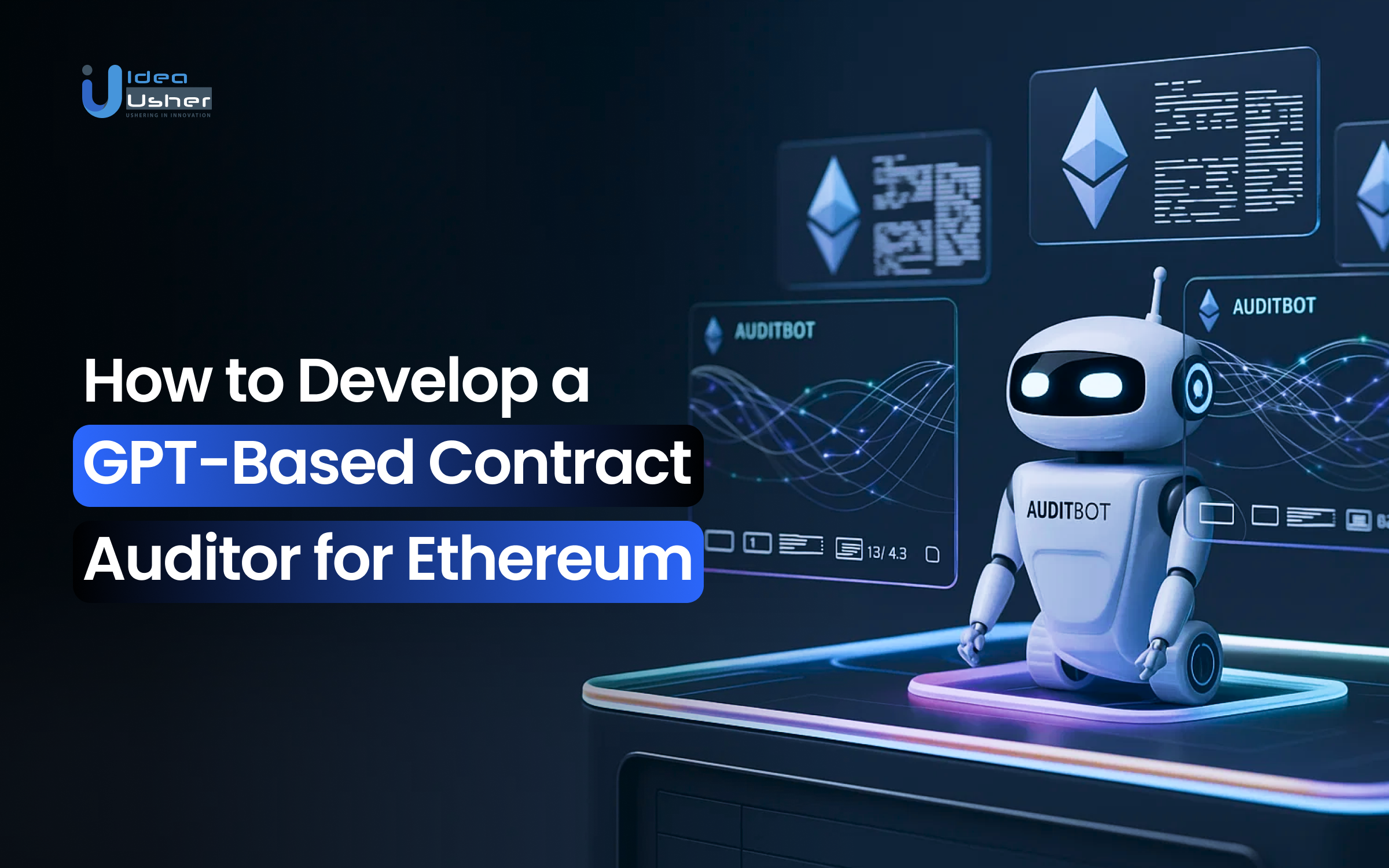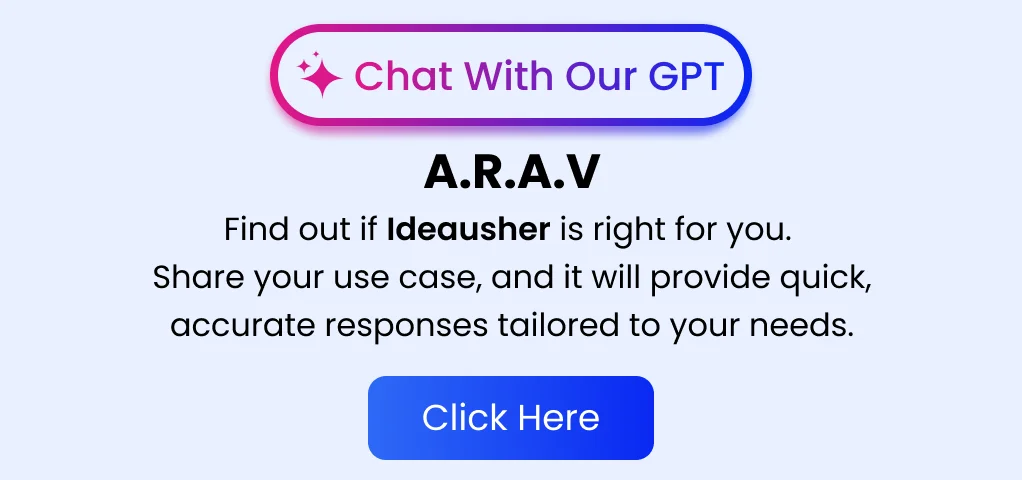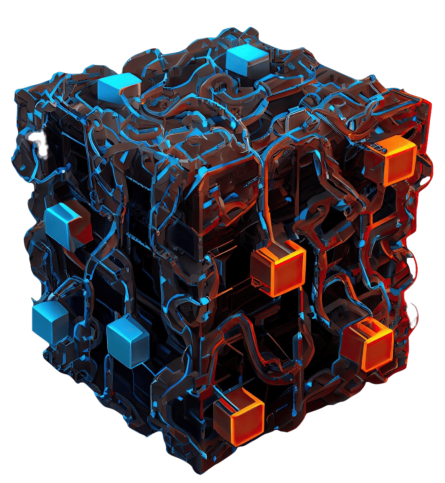With Ethereum locking up billions in value, security has become a top concern for DeFi, NFT, and DAO platforms. The increasing number of sophisticated hacks targeting smart contract vulnerabilities has made it clear that traditional auditing methods, while still valuable, aren’t enough on their own. To keep pace with these growing threats, many businesses are turning to GPT-based contract auditors. These go beyond basic analysis, offering real-time security suggestions and insights.
By using advanced AI models, they make it easier to protect Ethereum-based systems in a way that’s faster, smarter, and more proactive, helping stay one step ahead of potential risks.
Over the past decade, we’ve guided numerous businesses in integrating GPT-powered contract auditors that leverage the power of AI to analyze code in real-time, spot vulnerabilities, and suggest secure coding practices. IdeaUsher has worked closely with clients to ensure that these auditors predict exploit vectors based on patterns from past vulnerabilities, offering highly adaptable, proactive solutions. Through this blog, we aim to share our experience, helping you build scalable and secure Ethereum-based systems.
Key Market Takeaways for GPT-Based Contract Auditors
According to PolarisMarketResearch, the blockchain security market is experiencing rapid growth, expected to rise from $3.8 billion in 2024 to $538 billion by 2034. This significant expansion is driven by increasing cybersecurity threats and the widespread adoption of blockchain technology, particularly within DeFi. As more critical applications transition to decentralized networks, the need for efficient and automated smart contract auditing has become more pressing.
Source: PolarisMarketResearch
GPT-based contract auditors are becoming a key solution for Ethereum smart contract security. Tools like AuditGPT use advanced large language models to analyze contracts, detect vulnerabilities, and ensure compliance with Ethereum standards. These automated systems outperform traditional manual audits by offering faster, more accurate results with fewer errors, making them an essential tool as the complexity of smart contracts continues to grow.
AI-driven audit platforms are gaining traction, with companies like ChainGPT securing significant investment to expand their capabilities across multiple blockchains. Established security firms such as CertiK and Quantstamp are also integrating GPT-based tools to enhance their offerings, forming strategic partnerships with top DeFi projects and exchanges to strengthen blockchain security and improve the reliability of decentralized applications.
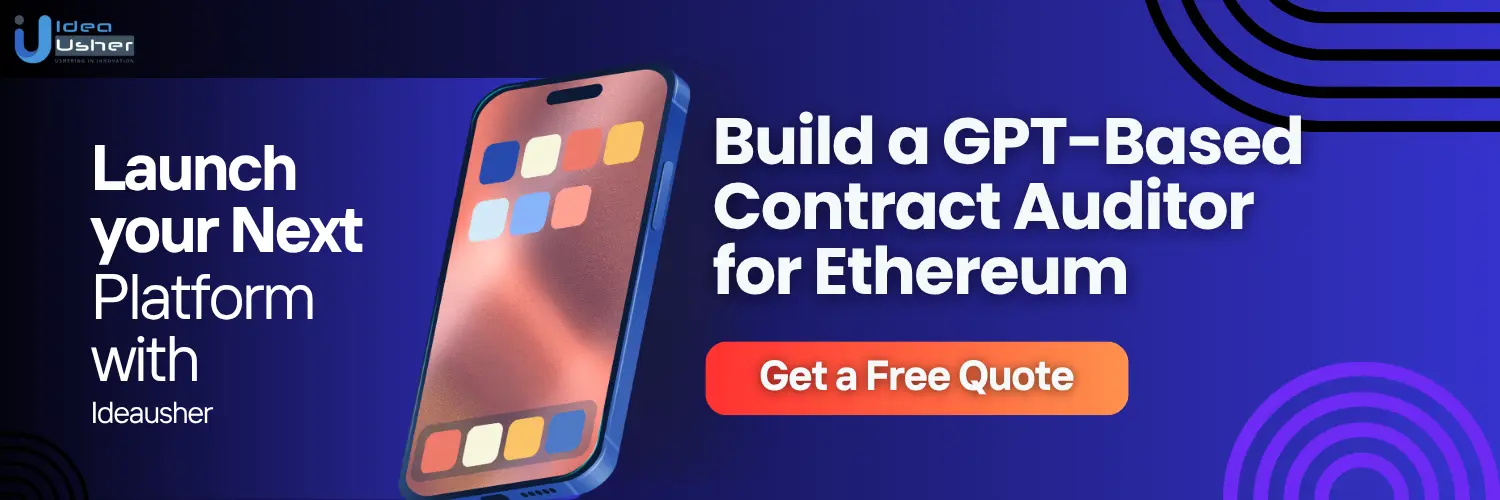
What is a GPT-Based Contract Auditor for Ethereum?
A GPT-based contract auditor is a cutting-edge, AI-driven tool designed to enhance the security and efficiency of Ethereum smart contracts. Powered by advanced NLP and ML, it’s trained on vast datasets that include smart contracts, audit reports, and known blockchain vulnerabilities. This AI auditor performs the following functions:
- Reading & Understanding Solidity Code: The auditor interprets Ethereum smart contracts written in Solidity, similar to how a human auditor would analyze code, understanding its logic, structure, and intent.
- Vulnerability & Risk Analysis: It evaluates contracts for potential vulnerabilities, inefficiencies, and compliance issues, pinpointing flaws that could be exploited by malicious actors.
- Generating Actionable Recommendations: Based on its findings, the tool provides concrete suggestions for improving security and fixing vulnerabilities, often in the form of code adjustments or architectural changes.
Unlike traditional static analysis tools that are limited by predefined rule sets, a GPT-based auditor can dynamically interpret the business logic and economic incentives of a contract, allowing it to identify novel vulnerabilities that traditional methods may overlook.
Types of Analysis Performed by GPT-Based Auditors
A GPT-based contract auditor performs a range of sophisticated checks to ensure the integrity and security of Ethereum smart contracts:
| Analysis Type | Description |
| Static Code Analysis | Scans the contract’s code for syntax errors, unsafe patterns, and known vulnerabilities such as reentrancy attacks and integer overflows. |
| Semantic Intent Matching | Checks if the contract performs its intended function correctly, ensuring that the actual behavior aligns with the developer’s intent, identifying logic flaws. |
| Bytecode-Level Analysis | Analyzes the Ethereum Virtual Machine (EVM) bytecode and compares it with the source code, detecting low-level threats like storage collisions and delegatecall hijacking. |
| Threat Modeling | Evaluates potential attack vectors such as front-running or oracle manipulation, and simulates exploit scenarios before deployment to identify weaknesses. |
| Gas Optimization Suggestions | Recommends optimizations for cheaper opcodes and more efficient storage strategies, reducing gas fees and improving contract efficiency. |
| Compliance Checks | Ensures the contract adheres to regulatory standards like the FATF travel rule and OFAC sanctions, ensuring global compliance. |
Why Businesses Are Investing in GPT-Based Auditors?
Organizations, including enterprises and blockchain platforms, are increasingly turning to AI-driven contract auditors for several compelling reasons:
- Faster Audits: AI can analyze smart contracts in minutes, drastically reducing the time it takes compared to manual audits, which can span weeks.
- Reduced Manual Overhead: It minimizes the need for expensive, time-consuming human experts, streamlining the audit process and cutting down on costs.
- Increased Developer Productivity: GPT-based auditors provide real-time feedback as developers write code, enabling immediate identification and resolution of issues before deployment.
- Proactive Security: By integrating real-time threat intelligence, the AI can identify zero-day exploits and potential vulnerabilities that might otherwise go unnoticed.
- Investor Confidence: Automated, transparent audit reports foster greater trust among investors and stakeholders, especially in decentralized finance (DeFi) protocols where security and compliance are paramount.
How GPT-Based Contract Auditors for Ethereum Work?
GPT-based Ethereum contract auditors go beyond syntax checks by deeply understanding both the code and its business logic. They analyze everything from high-level patterns to low-level bytecode, ensuring security and efficiency. These auditors also stay updated on emerging threats, using real-world data to fine-tune their assessments.
1. Semantic Understanding of Solidity & Business Logic
GPT-based contract auditors go far beyond simple syntax checking by gaining a deep understanding of both code structure and business intent. This is achieved through:
Training on Annotated Solidity Datasets: The AI model is trained on large datasets of verified smart contracts and their audit reports, learning how different code patterns correlate with security outcomes.
Documentation and Specification Analysis: The system processes ERC standards, developer documentation, and protocol whitepapers to understand the intended behaviors and compare them with actual implementations.
Logic Error Detection: The system identifies errors in logic, such as:
- Incorrect fee calculations
- Reward distribution vulnerabilities
- Privilege escalation risks
- Erroneous state machine transitions
Behavioral Pattern Recognition: The auditor flags deviations from established secure patterns in decentralized finance, such as ensuring reentrancy guards are properly implemented and that safe math functions are used. For example, in staking contracts, it may spot when reward calculations could be manipulated by timestamp dependency.
2. Bytecode-Level Analysis
As deployed contracts exist as Ethereum Virtual Machine (EVM) bytecode, the auditor performs in-depth binary analysis:
| Analysis Category | Focus Area | Details |
| EVM Execution Flow Reconstruction | Opcode Mapping | Reconstructs opcodes to map to higher-level behaviors and detect malicious patterns. |
| Source-to-Bytecode Verification | Compiled Output Hash Comparison | Compares bytecode’s hash to source code to verify integrity. |
| Compiler Version Discrepancies | Detects compiler version mismatches, indicating potential tampering. | |
| Hidden Opcode Injections | Identifies injected opcodes that could exploit vulnerabilities. | |
| Critical Opcode Analysis | DELEGATECALL Misuse | Detects misuse of DELEGATECALL that can lead to proxy pattern risks. |
| SELFDESTRUCT Conditions | Identifies dangerous SELFDESTRUCT calls that may lock funds or destroy contracts. | |
| Storage Slot Collisions | Detects conflicting storage slots that can cause unintended state changes. | |
| Unchecked CALL Value Transfers | Finds ether transfers without success/failure checks, causing vulnerabilities. | |
| Reentrancy at Machine Level | JUMPDEST Instructions | Analyzes jump destinations for potential reentrancy vulnerabilities. |
| Gas Left Checks | Identifies gas patterns that could lead to reentrancy exploits. | |
| Storage Access Sequences | Reviews storage access patterns that could be exploited in reentrancy attacks. |
3. Mitigating Hallucinations and Ensuring Accuracy
To maintain reliability at an enterprise level, the auditor uses several verification layers:
- Hybrid Analysis Architecture: It combines GPT outputs with other static analyzers (like Slither), integrates symbolic execution (such as Mythril), and runs formal verification where necessary.
- Reinforcement Learning from Auditor Feedback (RLHF): Human auditors score AI findings, and the model improves through continuous learning via reward modeling. This creates a feedback loop that ensures increased accuracy over time.
- Confidence Scoring System: Each finding is given a confidence score from 0-100%. Low-confidence results are flagged for human review, and the system learns from past mistakes to reduce false positives/negatives.
- Explainable AI Features: The system provides transparency by generating natural language reasoning for each finding, citing relevant CVEs, and showing how specific code maps to vulnerabilities.
4. Proactive Security & Optimization Assistance
The AI-powered auditor not only finds vulnerabilities but also helps prevent them:
- Gas Optimization Engine: Recommends cost-effective storage patterns, identifies unnecessary operations like SLOAD, suggests unchecked blocks where safe, and proposes more efficient data structures.
- Automated Threat Modeling: The system generates attack trees for complex protocols, simulates multi-contract exploits, and estimates the financial impact of vulnerabilities.
- CI/CD Pipeline Integration: The system integrates seamlessly into development workflows by providing real-time feedback via Git pre-commit hooks, automated scan reports in pull requests, and security gates in deployment pipelines. It also tracks historical vulnerabilities for continuous improvement.
5. Retrieval-Augmented Generation
To stay up to date with emerging threats, the system features:
Live Knowledge Base Integration
The auditor pulls from a wide range of sources, including:
- Rekt.news hack database
- CVE disclosures
- Emerging attack patterns
- Latest audit findings
Context-Aware Analysis: The system enhances prompts with recent exploit data and cross-references findings with similar protocols. It also provides warnings about trending attack vectors.
Continuous Learning: The auditor is constantly retrained on new vulnerability patterns, maintaining temporal awareness of risks to ensure it detects emerging threats.
Implementation Example: For instance, when analyzing a lending protocol, the RAG system might immediately incorporate insights from a recent Compound Finance governance exploit, keeping the audit up-to-date with real-world threats.
Key Benefits of GPT-Based Contract Auditors for Businesses
GPT-based contract auditors help businesses launch faster by speeding up audits from weeks to hours, saving both time and money. They also offer continuous monitoring and easy-to-understand compliance checks, making security less of a headache. Plus, with real-time feedback, companies can ensure their contracts are secure while developing quickly.
Technical Advantages
1. Deep Semantic Understanding of Intent
GPT-based auditors go beyond just checking the syntax. They understand the developer’s intention, allowing them to detect vulnerabilities in the business logic that others might miss. This includes identifying risks in complex DeFi protocols, like yield farming contracts, which might have exploitable design flaws.
2. Rapid Vulnerability Identification
These auditors can scan codebases 10-100 times faster than manual audits, delivering quick results. By providing instant feedback during development via IDE plugins, developers can address security issues as they write code, speeding up the entire development process.
3. Bytecode and EVM-Aware Analysis
The auditor digs into bytecode, checking for version bugs, hidden backdoors, and costly opcode sequences. This deep-level analysis helps developers catch security flaws that might otherwise go unnoticed, ensuring contracts are both secure and efficient.
4. Auto-Suggest Remediation
When vulnerabilities are found, the system not only highlights them but also offers easy-to-understand fixes with code suggestions. Developers get multiple remediation options ranked by security and efficiency, making it easier to patch vulnerabilities without a hassle.
5. ERC Standard Compliance Checks
The system ensures that contracts comply with major ERC standards like ERC-20 and ERC-721. It flags any deviations and generates compliance reports, making it easier for businesses to meet regulatory requirements and avoid common pitfalls.
Business Advantages
1. Faster Time-to-Market
With audit cycles shortened from weeks to hours, GPT auditors help businesses bring new products to market much faster. By integrating security feedback directly into the development process, teams can move quickly without sacrificing security.
2. Reduced Cost of Security Audits
Traditional security audits can cost tens of thousands of dollars, but GPT-based auditing tools reduce this cost by up to 90%. With fixed, predictable pricing models, businesses can ensure their contracts are secure without breaking the bank.
3. Continuous Monitoring & Integration
These auditors offer ongoing monitoring, automatically scanning code for vulnerabilities during development and after deployment. This helps detect potential issues in real-time, ensuring contracts remain secure even after launch.
4. Higher Stakeholder Trust
Clear, easy-to-read audit reports and security scores give stakeholders the confidence that contracts are secure. By offering transparent results and a clear explanation of vulnerabilities, businesses can build trust with users and investors.
5. Stronger Ecosystem Positioning
By using GPT-based auditors, businesses can promote their commitment to security and regulatory compliance. This positions them as trustworthy players in the ecosystem, boosting investor confidence and enhancing their reputation.
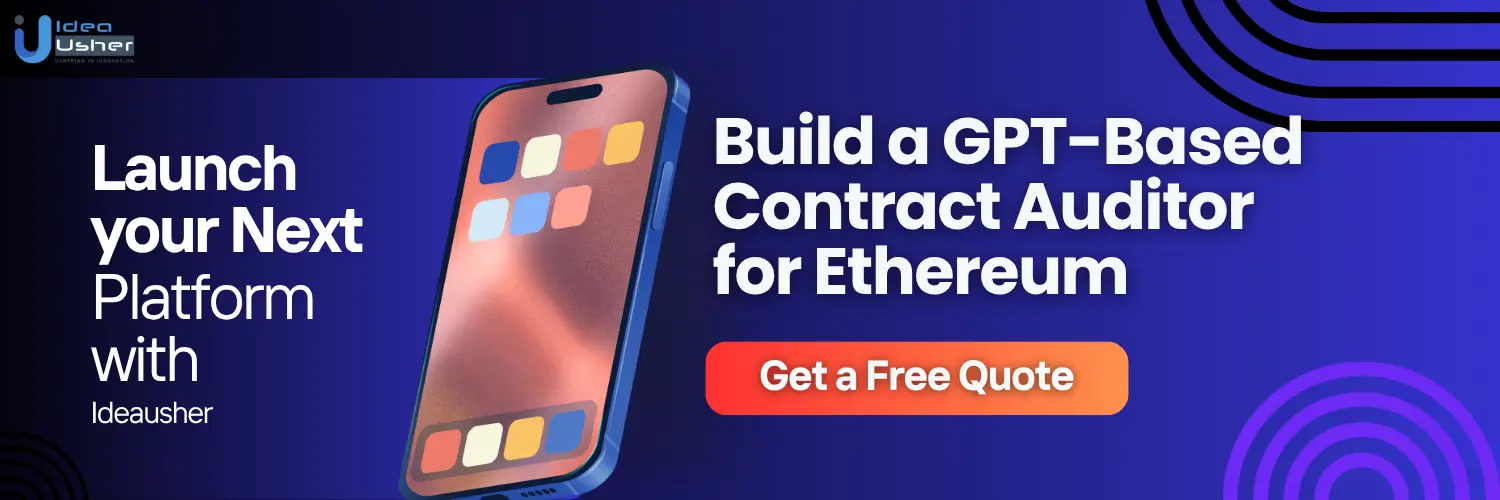
How to Build a GPT-Based Ethereum Contract Auditor?
We build customized GPT-based Ethereum contract auditors designed to provide top-tier security and efficiency for our clients. Our approach integrates the latest AI technology with deep knowledge of blockchain security to deliver a solution that adapts to the unique needs of each client. Here’s how we develop a GPT-based Ethereum contract auditor:
1. Collect & Curate Training Data
We gather a variety of smart contracts, including both secure and vulnerable ones, along with relevant audit logs, whitepapers, and documentation. This also includes EVM bytecode and opcodes, ensuring the AI learns from a broad range of real-world examples.
2. Fine-Tune a Pretrained GPT Model
We fine-tune a pretrained GPT model, like GPT-4 or LLaMA, using domain-specific data, including Solidity code and vulnerability reports. This helps the model understand the intricacies of Ethereum smart contracts and security issues.
3. Implement Analysis Pipelines
We connect the GPT model to analysis tools that examine code structure and flow, including AST parsers and data flow analyzers. This allows us to spot logical and structural issues while using symbolic execution and fuzzing for thorough testing.
4. Integrate External Knowledge Systems
We integrate a retrieval-augmented generation system to keep the model updated with the latest exploit databases, ERC standards, and code snippets. This ensures the AI is always working with the most current information.
5. Build User Interface or IDE Plugin
We create user-friendly interfaces, such as VS Code plugins or web dashboards, that provide real-time feedback and easy-to-read audit reports. This integration allows developers to address security issues during development.
6. Deployment
After building the auditor, we rigorously test it with known exploits and internal contracts to validate its performance. We continuously improve it through reinforcement learning and client feedback, ensuring it stays reliable and effective.
Challenges in Developing a GPT-Based Ethereum Auditor
Having worked with a diverse range of clients, we’re well-versed in the typical challenges that arise during GPT-based contract auditing. We’ve developed effective solutions to navigate these hurdles and guarantee smooth implementation. Here’s how we address them:
1. Lack of High-Quality Labeled Data
AI models require large amounts of accurately labeled training data to effectively identify secure versus vulnerable patterns, understand subtle exploit scenarios, and spot emerging attack vectors. Without high-quality data, the model’s accuracy and reliability suffer.
Proven Solutions
Synthetic Example Generation
We create realistic vulnerable and secure contract pairs using mutated versions of known secure contracts, AI-generated variants with controlled flaws, and adversarial testing frameworks to simulate a range of vulnerabilities.
Real-World Data Annotation
We curate datasets from verified exploit transactions, historical audit reports with fixes, and bug bounty submissions. Security experts label the data based on vulnerability types, severity, and remediation approaches, ensuring the model learns from real-world scenarios.
Implementation Tip: At IdeaUsher, we maintain a proprietary dataset of over 50,000 labeled contract examples to fine-tune our models, ensuring accurate results.
2. False Positives & Hallucinations
LLM-based models can sometimes invent non-existent vulnerabilities, miss real threats due to over-generalization, or offer incorrect remediation advice. This can make the audit process less reliable and lead to unnecessary development delays.
Reliability Framework
Hybrid Analysis Architecture
We combine multiple tools to ensure thorough analysis:
- GPT Model: Initial semantic analysis
- Slither/Mythril: Rule-based verification
- Symbolic Execution: Path exploration
- Formal Verification: Mathematical proofs
Confidence Scoring System: Every finding is assigned a confidence rating from 0-100%, with cross-tool verification and historical accuracy metrics to back up the results.
Explainable AI: Each recommendation includes a detailed technical rationale, code references, historical precedents, and severity justification, making the audit results transparent and understandable.
3. Rapidly Changing Threat Landscape
With new vulnerabilities emerging constantly, such as novel DeFi exploit patterns, EVM upgrade side-effects, and compiler optimization risks, keeping the AI model up-to-date is a continual challenge.
Continuous Learning System
Retrieval-Augmented Generation
We integrate real-time knowledge feeds from CVE databases, Chainalysis threat reports, auditor community forums, and protocol post-mortems to keep the AI up-to-date with the latest threats.
Adaptive Training Pipeline
We implement monthly retraining cycles, automated exploit pattern extraction, and feedback loops from security researchers to ensure the AI evolves alongside the threat landscape.
Community Reporting Integration
We link bug bounty programs, crowdsourced vulnerability tagging, and whitehat collaboration portals to ensure the system is constantly learning from the security community.
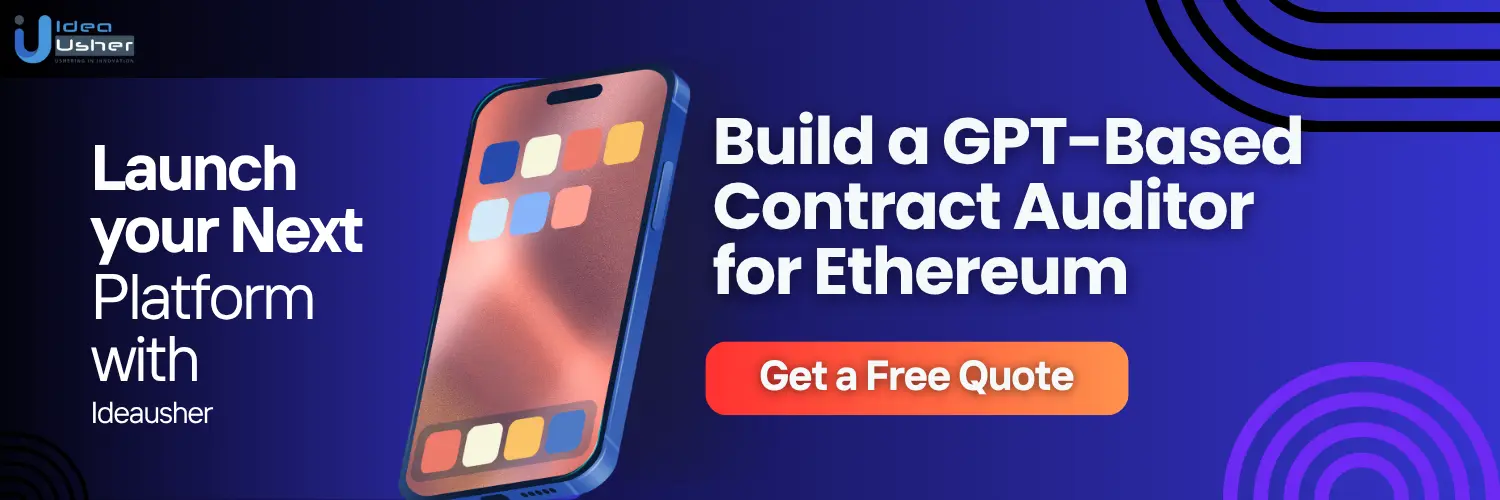
Essential Tools & APIs for Building GPT-Based Contract Auditors
We use advanced AI models for contract analysis, along with tools for detecting vulnerabilities in both static and dynamic contract code. Knowledge management systems keep the auditor up to date, while APIs ensure smooth deployment and integration. This creates a flexible, secure auditing solution.
1. AI/LLM Core Infrastructure
OpenAI GPT-4/GPT-4-turbo
We rely on GPT-4, particularly its turbo version, for complex reasoning tasks. Its 128k context window allows us to analyze large Ethereum contract codebases and understand intricate smart contract logic.
LLaMA 3/Mistral 7B
For clients who need to deploy solutions on their own infrastructure, LLaMA 3 and Mistral 7B offer flexible, open-source alternatives. These models provide the same level of sophistication for contract analysis, but are ideal for on-premise deployments.
2. Fine-Tuning Stack
Hugging Face Transformers
Hugging Face’s toolkit is critical for adapting models to specific smart contract use cases. With its pipeline support, it helps us preprocess Solidity datasets and efficiently fine-tune models for optimal performance.
LoRA/PEFT (Parameter-Efficient Fine-Tuning)
This technique allows us to fine-tune large models with minimal computational overhead. It’s crucial when tailoring GPT models to specific tasks like vulnerability detection and gas optimization, ensuring that the model becomes an expert without losing its general capabilities.
3. Smart Contract Security Toolchain
Security auditing requires a combination of static, dynamic, and formal analysis tools to cover all vulnerabilities, from simple issues to deep exploit paths:
| Analysis Type | Tool | Description |
| Static Analysis | Slither | Flags 80+ vulnerabilities and allows custom rule development. |
| Mythril | Simulates transactions to detect gas inefficiencies and logic flaws. | |
| Dynamic Analysis | Foundry/Forge | Fuzz testing tool for input simulation and invariant checking. |
| Echidna | Property-based testing to identify edge cases and crashes. | |
| Formal Verification | Manticore | Generates proofs, visualizes exploit paths, and checks multi-contract interactions. |
4. Knowledge Management System
To enhance the GPT-based model’s decision-making process, we integrate a powerful knowledge management system that pulls in real-time data and patterns:
Retrieval-Augmented Generation
- Pinecone/Weaviate: Vector databases for storing exploit patterns, enabling real-time similarity searches and hybrid keyword/semantic indexing for better data retrieval.
- LangChain/LlamaIndex: Powerful document ingestion pipelines and chunking strategies to manage and process large technical content, with prompt augmentation for better querying.
Audit Data Storage:
PostgreSQL/ArangoDB: Structured storage for audit findings with graph relationships between vulnerabilities, allowing for deep historical analysis.
5. Development & Deployment Stack
The development and deployment stack ensures smooth integration of the auditing tool into existing workflows and provides flexibility for deployment:
| Category | Tool | Description |
| Smart Contract Tooling | Hardhat/Truffle | Support plugin systems for audit integration, local blockchain simulations, and robust debug tracing. |
| CI/CD Integration | GitHub Actions/GitLab CI | Automates scan triggers with pre-commit hooks and generates detailed reports during the development process. |
| Developer Experience | VS Code Plugin API | Provides real-time in-IDE analysis, quick-fix suggestions, and interactive audit notebooks for enhanced workflow. |
| API Layer | REST/GraphQL Endpoints | Facilitates scan initiation, results retrieval, and webhook notifications for seamless integration. |
6. Enterprise Deployment Options
Enterprises require scalable and flexible deployment options to fit their specific infrastructure and security needs:
- Cloud SaaS Model: This model provides fully managed API endpoints, automatic updates, and compliance-ready reporting. It’s ideal for businesses looking for a hassle-free deployment that stays up-to-date with the latest security features.
- Hybrid Deployment: For more control, we offer hybrid solutions that combine on-premise analysis engines with cloud-based model serving. This setup ensures maximum flexibility while meeting the most stringent data security requirements, including air-gapped options for highly sensitive contracts.
Use Case: GPT-Based Auditor for DeFi Lending Platform
One of our clients, a rapidly growing DeFi lending protocol, came to us with a set of critical challenges related to scaling security as their platform expanded. Here’s how we helped them resolve these issues using our AI-powered GPT-based auditor.
The Challenge: Scaling Security for Growth
The DeFi lending protocol was facing several major pain points:
- Manual Audit Bottlenecks: The team was only able to perform comprehensive security reviews every 8 weeks, leaving gaps in ongoing security monitoring.
- Post-Deployment Surprises: A critical liquidation bug had been exploited, leading to a $150k loss.
- Mounting Costs: The protocol was spending $70k per year on bug bounties and $120k on emergency audits due to unanticipated vulnerabilities.
- Investor Concerns: With Series B funding on the horizon, investors were demanding enterprise-grade security measures.
The Solution: AI-Powered Continuous Auditing
We proposed a three-phase integration plan, leveraging our GPT-based contract auditor for continuous, real-time security monitoring and optimization.
Core Integration (Weeks 1-2)
GitHub Actions Pipeline: We set up the GPT auditor to automatically scan every pull request (PR) as it was made. The system integrated Slither and Mythril for hybrid verification, with security gates ensuring that any critical findings were flagged immediately.
VS Code Plugin: Developers had real-time vulnerability alerts directly in their IDE, along with quick fix suggestions and gas optimization hints for better code quality.
Advanced Protection (Weeks 3-4)
- Bytecode Monitoring: The GPT auditor now monitored deployed contracts and compared them with the original source code. This allowed for the early detection of anomalous transaction patterns, as well as potential exploits.
- RAG-Powered Exploit Early Warning: We implemented real-time retrieval of exploit data to warn of emerging attack patterns specific to the platform.
- Threat Modeling: Automated attack tree generation helped simulate liquidation scenarios and test for oracle manipulation risks, allowing the team to address these vulnerabilities proactively.
Optimization Phase (Ongoing)
As part of ongoing improvements, the system suggested optimizations to storage layouts, batch operations, and gas-efficient math libraries, ensuring the platform’s continued scalability and cost-effectiveness.
Quantifiable Results
| Metric | Before | After 6 Months |
| Audit Frequency | Quarterly | Every Commit |
| Critical Bugs Found | 3 (post-deploy) | 0 |
| Gas Costs | 42k avg/tx | 27k avg/tx |
| Audit Expenses | $190k/year | $28k/year |
| Insurance Premiums | 5.2% TVL | 3.1% TVL |
Key Discoveries
The GPT-based auditor uncovered several critical vulnerabilities that were addressed before deployment:
- Liquidation Threshold Flaw: This issue could have allowed bad debt accumulation. It was discovered during a pre-merge review and fixed with a simple 12-line patch.
- Interest Rate Precision Issue: The APR calculation had a 0.5% drift over time. This was resolved by implementing a new fixed-point math library.
- Front-Runnable Oracle Update: The system identified a 9-minute exploit window where an attacker could manipulate oracle updates. We addressed this by introducing a commit-reveal pattern for added security.
Business Impact
For Developers:
- 63% less time spent on security reviews, thanks to real-time feedback.
- Automated compliance documentation, reducing manual effort.
For Management:
- 40% reduction in security-related delays.
- Cleared all Series B due diligence checks, instilling investor confidence.
For Users:
- 35% reduction in gas fees due to gas optimization suggestions.
- Publicly verifiable audit reports, enhancing transparency.
Top 5 GPT-Based Contract Auditors for Ethereum
After extensive research, we’ve identified some of the leading GPT-based smart contract auditors for Ethereum, each offering unique features designed to enhance security and streamline the auditing process.
1. AuditGPT
AuditGPT utilizes GPT-4 for comprehensive Ethereum smart contract audits, breaking down complex tasks into manageable subtasks. It has demonstrated impressive results, detecting 50% more issues than traditional audits and reducing audit costs and time by a factor of 1,000. AuditGPT has identified 418 ERC violations across 230 contracts, with only 18 false positives, showcasing its efficiency and accuracy.
2. QuillShield
QuillShield by QuillAI is an advanced smart contract auditing tool for Ethereum that leverages powerful GPT-like language models alongside static analysis and reinforcement learning. It provides fast, reliable, and automated security audits, continuously improving its ability to detect vulnerabilities and suggest code repairs. With features like one-click fixes and detailed, transaction-proof vulnerability reports, QuillShield enhances efficiency and reduces risks at every stage of the smart contract lifecycle.
3. SmartAuditFlow
SmartAuditFlow employs an adaptive GPT-based “Plan-Execute” framework that customizes audit strategies to the complexity of each Ethereum smart contract. The LLM-powered system dynamically adjusts to new ERC standards, security patterns, and emerging threat vectors. In lab tests, SmartAuditFlow showed improved precision in detecting critical vulnerabilities, adjusting its checks in real-time as attack surfaces evolved. This makes it highly effective for long-term protocol upgrades and multi-stage contract deployments.
3. Code4rena
Code4rena operates using a unique “Wardens” model, engaging a competitive community of auditors, many of whom use GPT-augmented code review tools. Since joining Zellic in 2024, it has maintained its decentralized auditing approach, discovering millions of dollars in potential exploits each year. Code4rena’s community and AI-powered tools expedite audits, reviewing 20–50 contracts simultaneously and contributing to the security of some of the largest DeFi projects.
4. Kritisi
Kritisi offers a multichain audit solution for Solidity contracts, analyzing Ethereum and EVM networks. With AI-driven automated risk detection and real-time contract scoring, Kritisi helps developers improve contract security and robustness, providing valuable insights to reduce vulnerabilities and minimize exploit risks efficiently.
5. Zellic AI Auditor
Zellic, which acquired Code4rena, integrates GPT-style tools into its community-driven “Warden” audits. AI assists auditors in scanning code and generating vulnerability hypotheses, accelerating the auditing process. Zellic’s AI auditor combines crowd-sourced expertise with large language models to efficiently audit complex contracts and multi-contract systems, particularly in the fast-moving DeFi space.
Conclusion
GPT-based Ethereum contract auditors are a game-changer for smart contract security, offering deep insights, real-time support, and continuous learning. At IdeaUsher, we specialize in building and integrating these systems, customized to fit the unique needs of your DeFi, NFT, DAO, or Web3 platform, ensuring robust security and efficiency every step of the way.
Looking to Develop a GPT-Based Contract Auditor for Ethereum?
At IdeaUsher, we specialize in developing advanced GPT-based contract auditors designed to offer comprehensive security for your Ethereum smart contracts. Our auditors are built to:
- Automatically detect vulnerabilities such as reentrancy attacks, logic flaws, and gas inefficiencies that could put your platform at risk.
- Analyze both Solidity code and bytecode, ensuring no blind spots in your contract’s security.
- Seamlessly integrate into your development workflow, making security checks a natural part of your process without disruption.
Why Choose Us?
- 500,000+ hours of coding experience, including engineers from top-tier companies
- A proven blockchain track record, highlighted by our latest DeFi audit projects
- Tailored AI solutions designed to meet the unique needs of your protocol
Secure your smart contracts before it’s too late!
Work with Ex-MAANG developers to build next-gen apps schedule your consultation now
FAQs
A1: GPT-based auditors go beyond pattern recognition, they understand the context, business logic, and intent behind the code. This allows for more accurate detection of complex vulnerabilities. Additionally, GPT models scale better and update faster, staying on top of the latest threats and vulnerabilities, ensuring ongoing security.
A2: No, a GPT-based audit serves as a powerful tool to assist and accelerate manual auditing, not replace it. Human auditors are still crucial for validating findings, making nuanced decisions, and providing context that AI alone cannot fully understand. The system enhances the audit process but works best alongside human expertise.
A3: We combine GPT with advanced tools like symbolic execution and expert feedback loops to validate findings and reduce false positives. Our system also features explainability layers, ensuring that every detected vulnerability is backed by a clear, understandable rationale, preventing AI-generated errors.
A4: Yes, GPT-based auditors are highly effective for continuous monitoring of live contracts. They can detect anomalies and vulnerabilities in real-time, providing ongoing protection and alerting teams to potential issues, ensuring smart contracts stay secure even after deployment.
